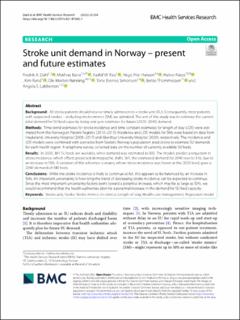| dc.contributor.author | Dahl, Fredrik Andreas | |
| dc.contributor.author | Barra, Mathias | |
| dc.contributor.author | Faiz, Kashif Waqar | |
| dc.contributor.author | Ihle-Hansen, Hege | |
| dc.contributor.author | Næss, Halvor | |
| dc.contributor.author | Rand, Kim | |
| dc.contributor.author | Rønning, Ole Morten | |
| dc.contributor.author | Simonsen, Tone Breines | |
| dc.contributor.author | Thommessen, Bente | |
| dc.contributor.author | Labberton, Angela Susan | |
| dc.date.accessioned | 2022-05-25T12:54:09Z | |
| dc.date.available | 2022-05-25T12:54:09Z | |
| dc.date.created | 2022-04-25T13:01:22Z | |
| dc.date.issued | 2022-03-15 | |
| dc.identifier.issn | 1472-6963 | |
| dc.identifier.uri | https://hdl.handle.net/11250/2996260 | |
| dc.description.abstract | Background: All stroke patients should receive timely admission to a stroke unit (SU). Consequently, most patients with suspected strokes – including stroke mimics (SM) are admitted. The aim of this study was to estimate the current total demand for SU bed capacity today and give estimates for future (2020–2040) demand.
Methods: Time trend estimates for stroke incidence and time constant estimates for length of stay (LOS) were estimated from the Norwegian Patient Registry (2010–2015). Incidence and LOS models for SMs were based on data from Haukeland University Hospital (2008–2017) and Akershus University Hospital (2020), respectively. The incidence and LOS models were combined with scenarios from Statistic Norway’s population predictions to estimate SU demands for each health region. A telephone survey collected data on the number of currently available SU beds.
Results: In 2020, 361 SU beds are available, while demand was estimated to 302. The models predict a reduction in stroke incidence, which offsets projected demographic shifts. Still, the estimated demand for 2040 rose to 316, due to an increase in SMs. A variation of this reference scenario, where stroke incidence was frozen at the 2020-level, gave a 2040-demand of 480 beds.
Conclusions: While the stroke incidence is likely to continue to fall, this appears to be balanced by an increase in SMs. An important uncertainty is how long the trend of decreasing stroke incidence can be expected to continue. Since the most important uncertainty factors point toward a potential increase, which may be as large as 50%, we would recommend that the health authorities plan for a potential increase in the demand for SU bed capacity. | en_US |
| dc.language.iso | eng | en_US |
| dc.publisher | BMC | en_US |
| dc.rights | Navngivelse 4.0 Internasjonal | * |
| dc.rights.uri | http://creativecommons.org/licenses/by/4.0/deed.no | * |
| dc.title | Stroke unit demand in Norway – present and future estimates | en_US |
| dc.type | Journal article | en_US |
| dc.type | Peer reviewed | en_US |
| dc.description.version | publishedVersion | en_US |
| dc.rights.holder | Copyright 2022 the authors | en_US |
| dc.source.articlenumber | 336 | en_US |
| cristin.ispublished | true | |
| cristin.fulltext | original | |
| cristin.qualitycode | 2 | |
| dc.identifier.doi | 10.1186/s12913-021-07385-1 | |
| dc.identifier.cristin | 2018899 | |
| dc.source.journal | BMC Health Services Research | en_US |
| dc.identifier.citation | BMC Health Services Research. 2022, 22, 336. | en_US |
| dc.source.volume | 22 | en_US |

